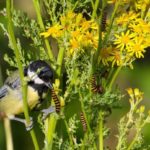RAGWORT – Loved and Loathed
Ragwort
Loved and Loathed
Loved…
By naturalists as it a renowned ‘weed’ of paddocks, pastures and waste ground, and is currently in flower as one of our late flowering native species.
The yellow flower heads of the Common Ragwort are a valuable nectar source for hundreds of insects and are the food plant of at least 77 species of insect herbivores, 27 species of moths, including the Cinnabar Moth, 22 species of thrips (slender insects), 13 species of bugs, 9 species of flies, 6 species of beetles and is the 7th highest pollinator of our native plants. Most importantly, as it flowers so late in the year, it is a vital food source for bees as they prepare to go into hibernation.
It is the unofficial flower of the Isle of Man – loved by many.
Loathed…
Hated and dreaded by stock and horse owners, particularly the latter, as the Common Ragwort carries a poison which can accumulate in the horse and, in extreme circumstances, cause death. However, this is in exceptional cases and if there is plenty of grass, horses don’t choose to eat it. It is only usually eaten by stock or horses if grass is in short supply.
It has a strange nickname ‘Stinky Willie’ as the plant was said to have been spread in the path of William, Duke of Cumberland, as the Jacobite Rebellion reached its peak at the Battle of Culloden in 1746.
Isabella Tree, author of the book ‘Wilding’, gives the Common Ragwort centre stage as a great rewilding emblem.
Known as ‘Cushag’, it is the unofficial national flower of the Isle of Man, loathed by many.
There is a poem, entitled ‘The Cushag’ by the Manx poet, Josephine Kermode (1832-1957) which offers a middle way.
Athene English
